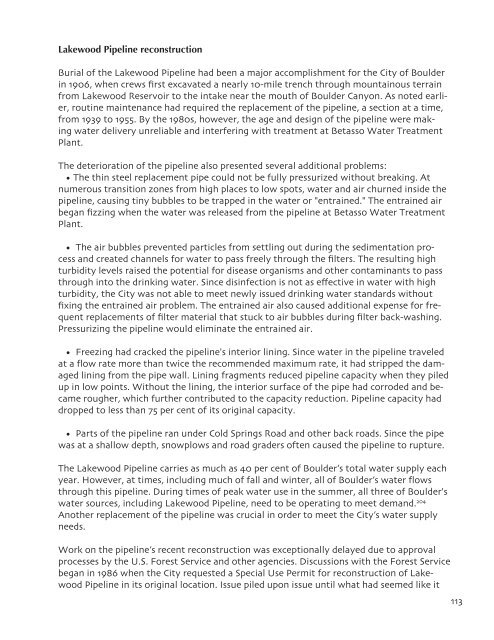You also want an ePaper? Increase the reach of your titles
YUMPU automatically turns print PDFs into web optimized ePapers that Google loves.
Lakewood Pipeline reconstruction<br />
Burial of the Lakewood Pipeline had been a major accomplishment for the City of Boulder<br />
in 1906, when crews first excavated a nearly 10-mile trench through mountainous terrain<br />
from Lakewood Reservoir to the intake near the mouth of Boulder Canyon. As noted earlier,<br />
routine maintenance had required the replacement of the pipeline, a section at a time,<br />
from 1939 to 1955. By the 1980s, however, the age and design of the pipeline were making<br />
water delivery unreliable and interfering with treatment at Betasso Water Treatment<br />
Plant.<br />
The deterioration of the pipeline also presented several additional problems:<br />
• The thin steel replacement pipe could not be fully pressurized without breaking. At<br />
numerous transition zones from high places to low spots, water and air churned inside the<br />
pipeline, causing tiny bubbles to be trapped in the water or "entrained." The entrained air<br />
began fizzing when the water was released from the pipeline at Betasso Water Treatment<br />
Plant.<br />
• The air bubbles prevented particles from settling out during the sedimentation process<br />
and created channels for water to pass freely through the filters. The resulting high<br />
turbidity levels raised the potential for disease organisms and other contaminants to pass<br />
through into the drinking water. Since disinfection is not as effective in water with high<br />
turbidity, the City was not able to meet newly issued drinking water standards without<br />
fixing the entrained air problem. The entrained air also caused additional expense for frequent<br />
replacements of filter material that stuck to air bubbles during filter back-washing.<br />
Pressurizing the pipeline would eliminate the entrained air.<br />
• Freezing had cracked the pipeline's interior lining. Since water in the pipeline traveled<br />
at a flow rate more than twice the recommended maximum rate, it had stripped the damaged<br />
lining from the pipe wall. Lining fragments reduced pipeline capacity when they piled<br />
up in low points. Without the lining, the interior surface of the pipe had corroded and became<br />
rougher, which further contributed to the capacity reduction. Pipeline capacity had<br />
dropped to less than 75 per cent of its original capacity.<br />
• Parts of the pipeline ran under Cold Springs Road and other back roads. Since the pipe<br />
was at a shallow depth, snowplows and road graders often caused the pipeline to rupture.<br />
The Lakewood Pipeline carries as much as 40 per cent of Boulder’s total water supply each<br />
year. However, at times, including much of fall and winter, all of Boulder’s water flows<br />
through this pipeline. During times of peak water use in the summer, all three of Boulder's<br />
water sources, including Lakewood Pipeline, need to be operating to meet demand. 204<br />
Another replacement of the pipeline was crucial in order to meet the City’s water supply<br />
needs.<br />
Work on the pipeline’s recent reconstruction was exceptionally delayed due to approval<br />
processes by the U.S. Forest Service and other agencies. Discussions with the Forest Service<br />
began in 1986 when the City requested a Special Use Permit for reconstruction of Lakewood<br />
Pipeline in its original location. Issue piled upon issue until what had seemed like it<br />
113



